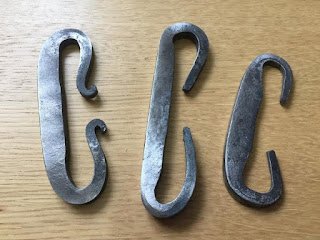This is a silver denarius from the time of Augustus. On the reverse you can see the sacred shield (ancile) that is said to have fallen from heaven, during the reign of Numa Pompilius, the second king of Rome...
Apparently the ancient sources gave many different potential etymologies for the word "ancile". Like being derived from Greek ankylos (ἀγκύλος) meaning crooked...Crooked what? Basically etymology was and still is unknown...
Now I am beginning to believe that god has a very good sense of humour and is basically taking the piss...This is Coat of Arms of Serbia. Stemmatographia by Hristofor Zhefarovich (1741)...
It is a cross with 4 fire-steels, of the type used since Roman times...These are used to strike a piece of flint to produce a spark when kindling fire...
In Serbian, and many other Slavic languages, these fire-steels are called "ocila", which basically just means "steels", plural of "ocil" meaning steel...
The word is cognate with Medieval Venetian azzal (steel) and Medieval Greek ἀτσάλιν (iron)...Both apparently from Late Latin acies (steel) which originally meant sharp and which comes from Indo-European root h₂eḱ - ( sharp )...
Now look at the ancile shield again. What do you see in the centre of the shield? Four arches. Four crooked irons? 4 fire-steels?
Or maybe not...Romans would have surely known this...Or Maybe not...Numa Pompilus, to whom many of Rome's most important religious and political institutions are attributed to, including ancile, was Sabine not Roman...
Now I am not saying that ancile and ocila has anything to do with each other...Just that God has a wicked sense of humour...
Why? Cause I don't think that Slavic "ocila" is linguistically linked to "ancile"...But it is possible that the Serbian cross with 4 ocila might point at what "ankylos" (ἀγκύλος), "crooked" thing could have given the name to "ancile": crooked steel...fire-steel...Maybe...




Any idea why there are 2 anciles on the coin? They remind me of the two balancing scales of Libra.
ReplyDeleteI think shields were used long before steel or iron, and that the etymology ties them to the first shelters of man, the domeshield of wicker round frame and broadleaf shingles. In Mbuti this is mongolu, similar to ankylo in Greek, kilp in Estonian, gulu in Chinese, mburojë in Albanian, skjöldur in Icelandic, kalkan in Turkish, perisai in Malay and arigolu in Indic (coracle), ngao in Swahili, but not so close to štit or ekran in Croatian.